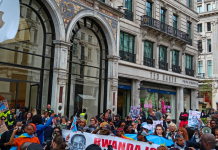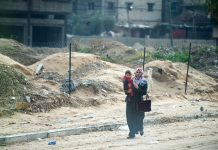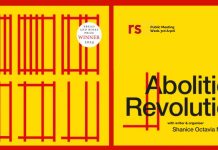The Arabian peninsula played a central role in the development of the oil industry over the last hundred years. Mykola Macke reviews an important book which brings together the history of development in the region with the parallel evolution of world shipping routes as the life-blood of world capitalism.
Laleh Khalili, Sinews of War and Trade (London: Verso , 2020) 368 pp. £20.00.
***
The recent blocking of the Suez Canal by the container ship Ever Given made global headlines. Terrifying figures were produced of ‘losses’ to global trade and production. Striking images were produced of the ship – a giant industrial object – surrounded by the natural landscape of the desert. It could be read as the tale of Frankenstein, the human creation now out of control. But such ships are everywhere. While containerships are the most visible, because of their gargantuan size, they only carry around 23% of dry cargoes (although 70% of world cargo by value). Oil tankers account for around 30% and bulk carriers (coal, ore, grain, raw materials) much of the rest. The biggest traded commodity by volume is not oil however, but sand.
Ships are both capital goods and carriers of raw materials and commodities. They are integral to the capitalist system of production, distribution and consumption. There is effectively a giant conveyor belt of ships which continually circumnavigate the world, stopping only briefly (a few hours at most) to load and unload, or when forced into dry dock for maintenance and repairs. Within a global economy, the drum beat of capital marshals all individual states to integrate their productive forces into the mass of global production.
To do this they need access to the conveyor belt of sea routes and the ships that sail them. Immense projects of land reclamation, dredging, sea defences, port construction, infrastructure development, oil and chemical terminals, warehouses, roads, railways and telecommunications networks have been completed around the world. Together they form the ticket of entry into the global markets; not just for goods but also for capital investment and finance.
In an underlying process which accelerated after the Second World War, both ships, and most port side activities morphed from being labour intensive to capital intensive. Ships of 10,000 dwt (dead weight tonnage) in 1921 which might have had a crew of 45-50 have been replaced by ships of 200,000 dwt with a crew of 25-30. There has been talk for the past two decades of dispensing with that crew altogether and it is certainly technically feasible.
A great deal of dock work has also experienced a qualitative change from manual labour to mechanical, electrical, pneumatic and computerised power. Thousands of individual boxes moved by hand and trollies have been replaced by standardised containers which are moved with great speed by massive cranes. This makes for faster speed of movement for goods and for the capitalists, that means faster realisation of profits.
Capitalism and the making of the ‘Middle East’
Laleh Khalili sets to look at these – and several other – issues from the perspective of the Arabian peninsula. She outlines the historical development of the region and traces the changes in capital formation, the ways in which infrastructure, ports, terminals and warehouses are built on the basis of commercial and political competition and rivalries. Her analysis brings together the role of ships, labour and automation and the integration of military and industrial objectives. The history is grim and brutal as are the current regimes and their strategies. The past and the present are entwined and it will take a powerful force from below to break them.
Colonial and imperialist rivalries were primarily about raw materials, access to markets, production and capital investment. The kaleidoscope of interests constantly changed over time and continues to change, forever creating new patterns and shapes. Competition between France and Britain in the nineteenth century suggested to the British ruling class that steam power would be a stronger military weapon than sail. Coal was needed and so Aden was invaded in 1839 to provide a coaling station. Tensions between Britain, Germany and Russia in the region were part of the pressures which blew up in the First World War.
The discovery of oil did much to change the dynamics of power, but the presence of oil – and the Suez Canal – made the whole of the Middle East of great strategic and military importance to all of the warring states in the Second World War. For many, war didn’t simply end in 1945. Egypt was invaded by Israel, France and Britain in 1956. There were wars again involving the state of Israel in 1967 and 1973. The Lebanese civil war from 1975 to 1990, the Iran-Iraq war from 1980-1988 (during which over 400 ships were attacked), Operation Desert Shield and Desert Storm in 1990-91 and the invasion of Iraq in 2003 are just some of the conflicts in the region which shifted political alliances and patterns of trade and investment.
Wars were not the only force for change, however. There were wide-spread anti-colonial and national independence movements, not just in the Middle East but across much of the world, some of which developed during the Second World War and expanded thereafter. Strikes, attempts at union organisation and mass demonstrations in support of the Palestinians marked the end of the 1940s through to the 1970s. These were usually brutally and savagely suppressed by local regimes supported by their imperialist backers and ex-British army officers. Thousands were imprisoned, tortured, sexually abused, murdered, deported and forced into exile. The oppression continues. There are no trade unions in many of the ports in the region, and at a global level, between 2015-2016 there was not a single recorded strike of seafarers, a collective group of around 1.5 million workers.
Khalili integrates the political and military histories with that of capital development, first that of the colonial powers, and then the development of regional accumulations of capital. A key determinant of this has been the development of the forces of production. She shows how in the Arabian peninsula a huge port and logistics network, with oil terminals, warehouses, free industrial zones and an infrastructure of roads, railways and telecommunications has been constructed. Deep water ports have been dug out of mud flats and require constant dredging. Sea defences and harbour structures have wreaked havoc with marine environments and traditional industries of fishing and pearl diving. All of these ports, shipping lines, oil producers, cities and ruling elites compete against each other. Rather than capitalism creating rationality and efficiency, it has created a topography of conflict, tension and war.
A regime of corruption and repression
All aspects of this development, the award of contracts, running of ports, control of shipping, movement of goods, state and commercial governance is saturated with corruption. Law tends to be European, a colonial legacy, but it is used selectively and as Khalili points out, ‘law is malleable in the service of power’. Everything the rulers and companies do is obscured by a haze and fog of shell companies, tax evasion and off-shore financial management. Regulations is applied selectively to ships and shipping, but in any sphere where regulations can be broken, then they will be.
But central to everything is labour and this means the working classes of the peninsula and other places it is connected to. Free zones have been created in the region, surrounded by razor wire, security guards, CCTV systems, elaborate monitoring and control. Across these zones and in the ports, labour is closely monitored and even representations about failure to pay wages (a common occurrence), poor food and bad accommodation are met with harsh measures. The lack of industrial rights is accompanied by the lack of political representation and in many places bans on meetings, demonstrations, political parties and trade unions.
Racialised regimes of labour have been created with almost caste like structures. Again, the colonial legacies of racial hierarchies are reflected in the organisation of officers, engineers and crew members in global shipping. Officers may be British, Dutch or Danish, but, globally, around 30% of all crew members are Filipinos. In the free-zones and ports, labour is also segregated in the labour camps and barracks where the manual workers are accommodated.
The rulers of the region and the ship and port owners use aggressive strategies to divide and rule the workforce, and to create climates of fear which prevent protest and workers organisation. Day-to-day oppression by the local ruling classes is buttressed by the very visible presence of the US military, with its long history of subverting democracy and crushing opposition movements. Should this not be enough workers can simply be dismissed and thus lose their very means of existence.
Khalili collates a vast library of facts, people, events and things – ports, ships, cities, commodities, raw materials. She explains the political developments and the underlying forces and processes which have created a capitalist image in the Arabian peninsula as a mirror image of capitalist images created throughout the world. Those who have read Marx will recognise The Communist Manifesto and large chunks of volume 1 of Capital in what she describes. Her book is an excellent starting point to understand the development of capitalism in the region, Marx a good starting point to understand the underlying forces and processes she outlines.
There are different ways this could play out. The preferred option for the global ruling classes is well illustrated in the plans for the new super-city of Neom in north-west Saudi Arabia. Reform seems unlikely, as the ruling edifice is both too strong and too brittle. It seems impossible that there could ever be a worker’s solution. But ‘the impossible has a habit of happening’ to quote the Steel Pulse song. The circuits of capital could be broken by a short circuit created by a united working class. That would by definition have to be revolutionary, to break through all that divides. The Ever Given’s blockage of the Suez Canal showed the fragility of the world system, and one obvious conclusion seems to be that if a ship with a crew of 25 can have such an impact on global capital, what might a larger crowd achieve?


















